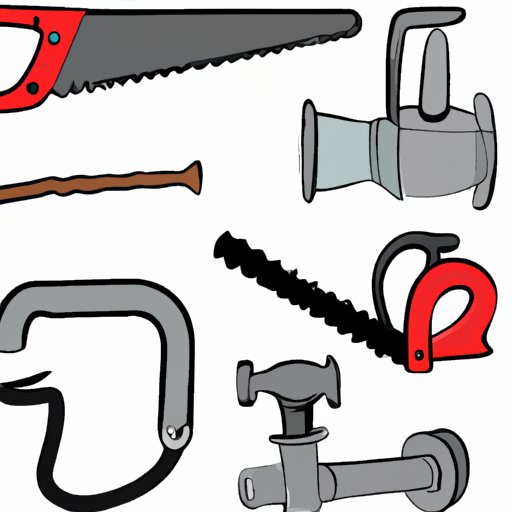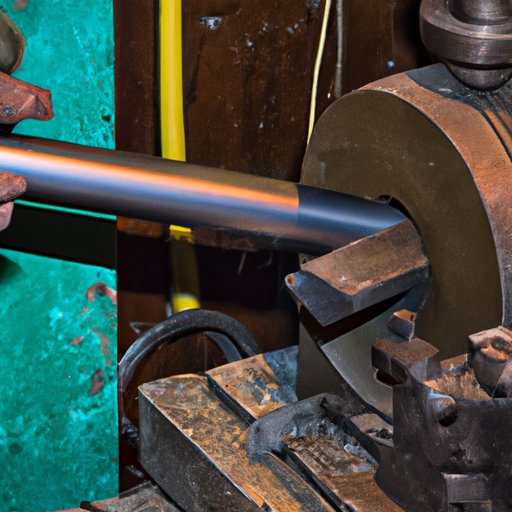
Introduction
Cast iron pipes have been used in plumbing for centuries, but cutting them can present a challenge for DIYers and professionals alike. Whether you’re replacing an old pipe or repairing a broken one, selecting the right pipe cutting method can be crucial to the success of your project. In this article, we’ll explore the different methods of cutting cast iron pipe and weigh the pros and cons of each.

The Traditional Way of Cutting Cast Iron Pipe with a Snap Cutter
A snap cutter, also known as a soil pipe cutter, is a tool designed specifically to cut cast iron pipes. It works by using a chain to squeeze and snap the pipe apart. Here’s how to use a snap cutter to cut cast iron pipe:
1. First, measure the pipe to determine the length you need to cut. Mark the pipe with a pencil or marker at the point where you want to cut it.
2. Place the snap cutter on the pipe, with the chain around the pipe where you want to cut it. The jaws of the cutter should be on the side of the pipe that you want to keep.
3. Turn the handle of the snap cutter to tighten the chain around the pipe. You may need to turn the handle several times to fully tighten the chain.
4. Continue turning the handle until the pipe snaps apart.
Pros of using a snap cutter:
- Designed specifically for cutting cast iron pipes
- Cuts the pipe without producing any noise, dust, or sparks
Cons of using a snap cutter:
- Can only cut pipes up to a certain size
- Requires a good amount of physical strength to operate
- More expensive compared to other cutting tools
The Modern Way of Cutting Cast Iron Pipe with a Reciprocating Saw
A reciprocating saw, also known as a sawzall, is a handheld power tool that uses a back-and-forth motion to cut through various materials, including cast iron pipes. Here’s how to use a reciprocating saw to cut cast iron pipe:
1. First, make sure you have a metal-cutting blade suitable for cutting cast iron pipes. The blade should be long enough to cut through the pipe in one pass.
2. Put on safety gear, including eye protection and ear protection.
3. Mark the pipe with a pencil or marker at the point where you want to cut it.
4. Secure the pipe in place using a clamp or another stable surface.
5. Position the reciprocating saw at a 90-degree angle to the pipe, with the blade lined up with the mark you made. Turn on the saw.
6. Slowly move the saw forward and backward, allowing the blade to cut through the pipe.
Pros of using a reciprocating saw:
- Fast and efficient
- Can cut through pipes of various sizes
- Produces minimal dust and noise compared to other cutting tools
Cons of using a reciprocating saw:
- Requires a high-powered saw with a suitable blade
- May produce sparks, requiring extra safety precautions
A Method that Uses a Grinder to Cut Cast Iron Pipe
A grinder, also known as an angle grinder, can be used to cut through cast iron pipes. This method works by grinding away at the pipe until it breaks apart. Here’s how to use a grinder to cut cast iron pipe:
1. First, measure the pipe to determine the length you need to cut. Mark the pipe with a pencil or marker at the point where you want to cut it.
2. Put on safety gear, including eye protection and ear protection.
3. Choose a metal-cutting blade suitable for cutting cast iron pipes and attach it to the grinder.
4. Place the grinder at a 90-degree angle to the pipe, with the blade lined up with the mark you made. Turn on the grinder.
5. Move the grinder back and forth along the mark, grinding away at the pipe until it breaks apart.
Pros of using a grinder:
- Fairly inexpensive compared to other cutting tools
- Can cut through pipes of various sizes
Cons of using a grinder:
- Produces a lot of noise, dust, and sparks
- May require a high-powered grinder and several grinding wheels to complete the cut
How to Cut Cast Iron Pipe with a Hacksaw and a Vice
A hacksaw, combined with a vice to hold the pipe still, can be an effective way to cut through cast iron pipes. Here’s how to use a hacksaw and a vice to cut cast iron pipe:
1. First, measure the pipe to determine the length you need to cut. Mark the pipe with a pencil or marker at the point where you want to cut it.
2. Secure the pipe in a vice, being careful not to damage the pipe.
3. Put on safety gear, including eye protection and ear protection.
4. Choose a metal-cutting blade suitable for cutting cast iron pipes and attach it to the hacksaw.
5. Position the hacksaw at a 90-degree angle to the pipe, with the blade lined up with the mark you made.
6. Begin sawing back and forth, using moderate pressure. Occasionally stop sawing to dip the blade in oil to prevent it from overheating.
7. Continue sawing until you’ve cut through the pipe.
Pros of using a hacksaw and a vice:
- Relatively inexpensive and readily available
- Produces minimal sparks, dust, and noise
Cons of using a hacksaw and a vice:
- Requires a good amount of physical strength and patience to complete the cut
- May not be the best option for cutting through larger pipes
A Method that Uses a Rotary Pipe Cutter to Cut Cast Iron Pipe
A rotary pipe cutter, also known as a rotary tubing cutter, is a tool designed to cut through pipes of various sizes. This tool works by rotating a cutting wheel around the pipe until the pipe breaks apart. Here’s how to use a rotary pipe cutter to cut cast iron pipe:
1. First, measure the pipe to determine the length you need to cut. Mark the pipe with a pencil or marker at the point where you want to cut it.
2. Put on safety gear, including eye protection and ear protection.
3. Place the rotary pipe cutter on the pipe, with the cutting wheel lined up with the mark you made.
4. Tighten the cutter onto the pipe and rotate the cutter’s handle to begin cutting through the pipe.
5. Continue rotating the cutter until the pipe breaks apart.
Pros of using a rotary pipe cutter:
- Designed specifically for cutting pipes of various sizes
- Produces minimal sparks and dust
Cons of using a rotary pipe cutter:
- May require a good amount of physical strength, depending on the size of the pipe
- More expensive compared to other cutting tools
A Guide on Using a Pipe Cutter or Tubing Cutter to Cut Cast Iron Pipe
A pipe cutter, also known as a tubing cutter, is a tool designed to cut through pipes with ease. This tool works by using a circular cutting blade that cuts through the pipe as it’s tightened onto the pipe. Here’s how to use a pipe cutter or tubing cutter to cut cast iron pipe:
1. First, measure the pipe to determine the length you need to cut. Mark the pipe with a pencil or marker at the point where you want to cut it.
2. Put on safety gear, including eye protection and ear protection.
3. Place the pipe cutter or tubing cutter on the pipe, with the cutting blade lined up with the mark you made.
4. Tighten the cutter onto the pipe and rotate it around the pipe, gradually tightening it as you go.
5. Continue tightening the cutter until the pipe breaks apart.
Pros of using a pipe cutter or tubing cutter:
- Designed specifically for cutting pipes with a circular blade
- Produces minimal sparks and dust
Cons of using a pipe cutter or tubing cutter:
- May require a good amount of physical strength, depending on the size of the pipe
- May not be the best option for cutting through larger pipes
Cutting Cast Iron Pipe with a Cold Chisel and Hammer
A cold chisel and a hammer can be used to cut through cast iron pipes. This method works by chipping away at the pipe until it breaks apart. Here’s how to use a cold chisel and hammer to cut cast iron pipe:
1. First, measure the pipe to determine the length you need to cut. Mark the pipe with a pencil or marker at the point where you want to cut it.
2. Put on safety gear, including eye protection and ear protection.
3. Place the chisel on the pipe, with the blade lined up with the mark you made.
4. Use the hammer to strike the chisel, chipping away at the pipe.
5. Continue striking the chisel until the pipe breaks apart.
Pros of using a cold chisel and hammer:
- Relatively inexpensive and readily available
- Produces minimal sparks, dust, and noise
Cons of using a cold chisel and hammer:
- Requires a lot of physical strength and patience to complete the cut
- May not be the best option for cutting through larger pipes
- May produce uneven cuts, which can lead to leaks or other issues
Conclusion
Cutting cast iron pipes may seem daunting, but with the right tools and a bit of know-how, it can be a manageable task. Whether you choose to use a traditional snap cutter, a modern reciprocating saw, or one of the other methods we’ve outlined above, there are pros and cons to each method. Consider the size of your pipe, the amount of noise and dust you’re willing to tolerate, and your own level of physical strength and expertise when selecting the best cutting method for your specific needs. And as always, feel free to share your own tips and experiences in the comments below.





